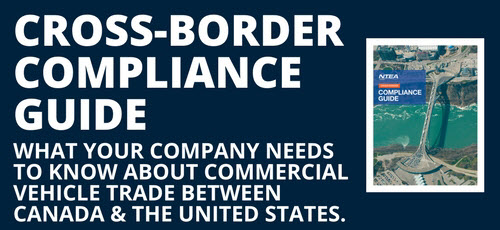By Jeffrey Phillips, Managing Director
Dawson Strategic
This article was published in the August 2017 edition of NTEA News.
Work trucks come in many different shapes, sizes and configurations — and customers appreciate the opportunity to look at specialized equipment and products up-close and in-person. For this reason, demonstration or exhibition vehicles are a great way to provide current and potential customers with a hands-on experience that no amount of glossy brochures can replicate.
For a U.S.-based company, there may be a time you want to drive that demonstration vehicle across the northern border into Canada. This article outlines key steps and considerations for that process.
Any vehicle imported into Canada needs to comply with all Canadian import laws. So, let’s look at a case where a U.S. company wants to temporarily bring a vehicle into the country for demonstration/exhibition purposes only — not to sell (also, there is no Canadian subsidiary acting as importer). Since the business is U.S. and not Canadian, this situation falls under customs legislation, and the organization responsible is Canada Border Services Agency (CBSA).
Know your options
As a company, you can prepare your own documents and transact with CBSA officials directly or authorize an agent to act on your behalf. The choice is yours, but remember, you can never outsource liability, so having a solid understanding of the process and paperwork requirements is critical regardless of the option you select.
In terms of process, an individual will drive the vehicle to the border to transact with a CBSA official and complete an E-29B – Temporary Admission Permit. This form will be completed by an officer at the border and cannot be filled out in advance. If you are not enlisting a customs broker, it’s important to ensure the individual driving the vehicle across the border is a company employee — not a hired transporter. A sample form is available in the Publications section of cbsa-asfc.gc.ca.
Come prepared
Supporting documentation is also required. The officer will be looking for three main pieces:
- A letter from the home company that should be specially prepared each time a demonstration vehicle crosses the border. This communicates your business is giving permission to the driver to use the vehicle for demonstration purposes. The letter should include a note that the vehicle is intended for demo purposes only as well as the name and date of birth of the individual driving.
- Ownership paperwork. All documentation related to vehicle ownership should be up-to-date and ready for presentation.
- Letter from a Canadian entity, company or organization where the vehicle will be used for demonstration purposes. It should indicate the reason the vehicle is entering Canada, duration of stay and contact information.
The E29-B permit is for a specified time, so take note of the expiration date. Failure to comply with terms and conditions of the permit may constitute an offense. It is advisable to speak with CBSA directly (800-461-9999) before bringing a demo vehicle into Canada. Careful preparation can save a lot of hassle down the road.
For more information on Canadian and global business resources, visit ntea.com/globalopportunities.
Dawson Strategic is a policy research and consulting company focusing on cross-border trade, economic and border issues. With offices in Ottawa and Toronto, the firm provides strategic analysis and guides advocacy activities as related to the Association’s government relations office in Canada.
